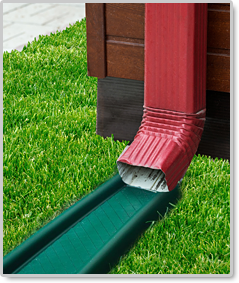Why You Need to Keep Rain Away From Your Foundation

WHY WORRY ABOUT GUTTERS AND DOWNSPOUTS?
The purpose of roof gutters is to prevent rainwater from draining or accumulating near the foundation of your house. Soaking the soil near the foundation can cause foundation walls to settle, basement walls to bulge, and the water pressure can even cause water to leak in through your basement walls.
Accumulating water around your foundation can also cause the humidity in your home to increase, which means you will need to run your air conditioner harder during the summer to feel comfortable, which will increase your electricity bills.
WHAT TO DO?
At the bottom of your downspouts, you should have splash pans which are made of concrete or plastic. The purpose of these downspout splash pans is to direct the water away from the foundation of your house. It is very important that these splash pans direct water at least 2-3 feet away from the foundation.
The following are the tasks you should do (or have done for you) at least once per year to be sure that your gutters and downspouts are working the way that they are supposed to:
Check Splash Pans
: Since these splash pans get shifted over time (by flowing water, lawn care equipment, kids playing, etc.), they should be checked to be sure that the downspouts are directed properly into the splash pans, and the splash pans are oriented properly to drain the water away (helpful accessory: downspout splash blocks).Ensure Proper Grading:
You should ensure that the grade of the ground at the end of the splash pans pitch away from your house, so that the water does not flow back towards your foundation.Remove debris from the gutters:
Leaves, sticks, sludge, etc. should be scooped out of the gutters with a gloved hand or a garden trowel. Do not try to remove the heavy debris with a garden hose, because pushing the debris into the downspouts can cause them to plug. NOTE: Be careful leaning your ladder against the gutters, as they can easily bend or break.Flush gutters
: Once the debris has been removed, flush the gutters with water from a garden hose to remove any remaining dirt or materials (see types, costs, and reviews of garden hoses).Clean downspouts:
To clean the downspouts, turn on garden hose full blast, and place it down into downspout openings. If badly blocked, a plumber's "snake" can be used to dislodge the debris (see types, costs, and reviews of plumber snakes).Inspect gutters for leaks
: Inspect the seams, end-caps, and any rusted areas for leaks. Repair as required with silicon sealer or patching materials (helpful accessory: gutter sealants).Inspect supports and slope of gutters
: While water is still in the gutter after flushing, check gutters for drainage. If water forms pools inside the gutters, then it does not have the proper drainage slope. Gutters should be sloped about one vertical inch for every 15-20 horizontal feet. Adjust hangers to achieve the necessary slope to drain water to the drain spouts. Also inspect the gutter hangers and replace ones that are damaged or loose (see costs and reviews of gutter hangers).Check inside gutter coating
: Protective compounds applied to the inside of the gutters can help significantly extend its useful life. Aluminum or copper can be coated with roof coating or spar varnish. Tin or carbonized metal can be coated with liquid roof coating, and wood gutters can be coated with linseed oil (see types, costs, and reviews of: roof coatings; spar varnishes; linseed oils for wood).Related Articles . . .
Keeping Your Basement Safe and Dry
Whether you have a finished basement or one that you rarely visit, this article and video tell you what to watch for to keep your basement safe and dry, and also includes ideas for space management.
Reducing Humidity in Your Home: Why & How-To
As we head towards the hot summer months, home humidity becomes a problem. This article discusses: the benefits of reducing home humidity; signs that your humidity is too high; and steps you can take to reduce humidity in your home.
Is It Time to Replace My Roof?
Most asphalt roofs have a lifespan of 15-25 years, but this can vary significantly based on a variety of factors. So how can you tell if your roof needs to be replaced sooner, before damage to your home starts?
Guide to Automatic Sprinklers
If you have an automatic sprinkler system for your lawn, this article and video will help you understand how your system works, how to winterize, and some operating tips for getting the most out of your system.








